KHAN YOUNIS, Gaza Strip (AP) — Israel said it targeted in a massive strike Saturday in the crowded southern Gaza Strip that killed at least 71 people, according to local health officials. Hamas immediately rejected the claim that was in the area.
Israeli officials confirmed that Deif and a second Hamas commander, Rafa Salama, were the targets. It was not immediately known whether Deif was dead. A military official later said they were “checking and verifying the result of the strike," and did not deny it took place in an area the Israeli military had designated as safe for hundreds of thousands of Palestinians.
Deif and Hamas’ top official in Gaza, , are believed by Israel to be the chief architects of the Oct. 7 attack that killed some 1,200 people in southern Israel and triggered the . Not seen in public for years, Deif has long topped Israel’s most-wanted list and is believed to have escaped multiple Israeli assassination attempts. On Oct. 7, Hamas issued a rare voice recording of Deif announcing the “Al Aqsa Flood” operation.
The strike came at a delicate time in cease-fire efforts. Deif's death would hand Israel a major victory and deal a painful psychological blow to Hamas. It also could give Israeli Prime Minister Benjamin Netanyahu a possible opening. He has said he will not end the war until Hamas’ military capabilities are destroyed, and Deif’s death would be a significant step in that direction.
Netanyahu was set to hold a press conference Saturday evening, while Defense Minister Yoav Gallant told the military to increase “operational readiness on all fronts.”
But Deif's killing could also risk encouraging Hamas to harden its positions in talks. He has been in hiding for more than two decades and is believed to be paralyzed. One of the only known images of him is a 30-year-old ID photo released by Israel. Even in Gaza, only a handful of people would recognize him.
In a statement, Hamas denied that Deif had been in the area. “These false claims are merely a cover-up for the scale of the horrific massacre,” it said.
The Gaza Health Ministry reported 71 dead and said at least 289 others were injured in the attack — one of the war's deadliest. Associated Press journalists counted over 40 bodies at overwhelmed Nasser Hospital nearby. Witnesses described an attack that included several strikes.
“A number of victims are still under the rubble and on the roads, and ambulance and civil defense crews are unable to reach them," the Health Ministry said.
The Israeli military asserted that “additional terrorists hid among civilians" and described the location as an area surrounded by trees and several buildings. An Israeli official said the strike hit a fenced area of Khan Younis that was run by Hamas, saying it was not a tent complex but an operational compound. The official described the strike as precise.
Witnesses said the strike landed in Muwasi, the Israeli-designated safe zone that stretches from northern Rafah to Khan Younis. Palestinians have fled to the coastal strip, sheltering mostly in sweltering tents with few basic services or supplies. More than 80% of Gaza’s 2.3 million people have been driven from their homes.
Footage of the aftermath showed a huge crater, charred tents and burnt-out cars. Victims were carried on the hoods and in the hatchbacks of cars, and on donkey carts and carpets.
“Children were all martyred here. We collected their pieces with our hands," said one Palestinian man who did not give his name. He estimated there were seven or eight missiles and asserted that first responders were targeted, too.
At the hospital, a baby in a pink shirt, her face covered with sand, cried while receiving first aid. A small boy lay motionless at the other end of the bed, one shoe gone. Many wounded were treated on the floor.
There was “the overwhelming stench of blood,” said Louise Wateridge, a spokesperson with the U.N. agency for Palestinian refugees who visited the hospital and spoke with several patients. Staff said there were no cleaning products left.
The blast threw a 2-year-old child into the air and the child's mother was still missing, Wateridge said. Another boy had his feet blown off, while an 8-year-old boy was killed. “They told me to go there to be safe,” his grieving mother told her of the area struck.
Neighboring Egypt, a mediator in cease-fire talks, condemned the strike. “These ongoing violations against Palestinian citizens add serious complications to the ability of the efforts currently being made to reach calm and a cease-fire,” its Foreign Ministry said in a statement. It also criticized the “shameful silence and lack of action from the international community.”
Egyptian, Qatari and U.S. mediators have been pushing to narrow gaps between Israel and Hamas over a proposed deal for a three-phase cease-fire and hostage release plan in Gaza.
The U.S.-backed proposal calls for an initial cease-fire with a limited hostage release and the withdrawal of Israeli troops from Gaza's populated areas. At the same time, the two sides will negotiate terms of the second phase, which is supposed to bring a full hostage release in return for a permanent cease-fire and complete Israeli withdrawal from Gaza.
Israel launched its campaign in Gaza after in which militants stormed into southern Israel and abducted about 250 people.
Since then, Israeli ground offensives and bombardments have killed more than 38,400 people in Gaza and wounded more than 88,000, according to the territory’s . The ministry does not distinguish between combatants and civilians in its count.
___
Federman reported from Jerusalem. Associated Press writers Jack Jeffery in Ramallah, West Bank, Fatma Khaled and Sarah el Deeb in Cairo and Abby Sewell and Bassem Mroue in Beirut contributed to this report.
___
Find more of AP’s coverage at
Mohamed Jahjouh And Josef Federman, The Associated Press




